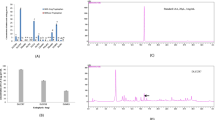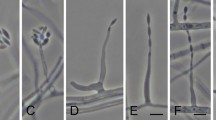Abstract
Thirteen endophytic fungi were isolated from roots of three orchid species, Spathoglottis affinis, Paphiopedelum bellatulum and Phaius tankervilleae. Of these, three fungal isolates produced high levels of indole-3-acetic acid (IAA) in culture medium supplemented with 2 mg/ml of L-tryptophan, and were selected for further analysis. Morphological characteristics and a phylogenetic analysis based on an alignment of internal transcribed spacer regions of nuclear rDNA indicated that the fungal isolates CMU-SLP 007 and CMU-NUT 013 belonged to family Tulasnellaceae, genus Tulasnella (the anamorphic genus Epulorhiza) and the fungal isolate CMU-AU 006 belonged to Colletotrichum gloeosporioides. These three fungal isolates produced maximum levels of IAA when grown in a culture medium supplemented with 4 mg/ml of L-tryptophan (C. gloeosporioides CMU-AU 006, 243.56 μg/ml and Tulasnella sp. CMU-SLP 007, 155.63 μg/ml) and 6 mg/ml of L-tryptophan (Tulasnella sp. CMU-NUT 013, 104.03 μg/ml). Thin layer chromatography revealed that all fungal IAA presented the same Rf value as the standard IAA. The biological activity of fungal IAA showed that it increased the length of stem forming roots and the number of roots of kidney bean (Phaseolus vulgaris), promoted seed germination, the length of roots and root to shoot ratio of corn (Zea mays) and increased the elongation of rice (Oryza sativa) coleoptiles when compared with all controls (water and culture medium treatments). In addition, the results of all biological activities using fungal IAA indicated that the quality of fungal IAA were similar to standard IAA.







Similar content being viewed by others
References
Ahmad F, Ahmad I, Khan MS (2005) Indole acetic acid production by the indigenous isolates of Azotobacter and fluorescent Pseudomonas in the presence and absence of tryptophan. Turk J Biol 29:29–34
Athipunyakom P, Manoch L, Piluek C (2004) Isolation and identification of mycorrhizal fungi from eleven terrestrial orchids. Kasetsart J (Nat Sci) 38:216–228
Barnett HL, Hunter BB (1987) Illustrated genera of imperfect fungi, 4th edn. Macmillan Plubishing Company, New York
Brundrett M, Sivasithamparam K, Ramsay M, Krauss S, Taylor R, Bunn E, Hicks A, Karim NA, Debeljak N, Mursidawati S, Dixon B, Batty A, Bower C, Brown A (2001) Orchid Conservation Techniques Manual, First International Orchid Conservation Congress-Training Course. Plant Science, King Park & Botanic Garden, Perth
Brundrett M, Scade CA, Batty AL, Dixon KW, Sivasithamparam K (2003) Development of in situ and ex situ seed baiting techniques to detect mycorrhizal fungi from terrestrial orchid habitats. Mycol Res 107:1210–1220. doi:10.1017/S0953756203008463
Chen J, Wang H, Guo SX (2011) Isolation and identificationof endophytic and mycorrhizal fungi from seeds and roots of Dendrobium (Orchidaceae). Mycorrhiza In press. doi:10.1007/s00572-011-0404-0
Chutima R, Dell B, Vessabutr S, Bussaban B, Lumyong S (2011) Endophytic fungi from Pecteilis susannae (L.) Rafin (Orchidaceae), a threatened terrestrial orchid in Thailand. Mycorrhiza 21:221–229. doi:10.1007/s00572-010-0327-1
Currah RS, Zelmer C (1992) A key and notes for the genera of fungi mycorrhizal with orchids and a new species in the genus Epulorhiza. Rept Tottori Mycol Inst 30:43–59
Currah RS, Zettler IW, McInnis TM (1997) Epulorhiza inquilina sp. nov. from Plantanthera (Orchidaceae) and a key to Epulorhiza species. Mycotaxon 61:335–342
Ehmann A (1977) The van Urk-Salkowski reagent-a sensitive and specific chromogenic reagent for silica gel thin-layer chromatographic detection and identification of indole derivatives. J Chromatogr 132:267–276
Felsenstein J (1985) Confidence limits on phylogenies: an approach using the bootstrap. Evolution 39:783–791. doi:10.2307/2408678
Hasan HAH (2002) Gibberellin and auxin production by plant root-fungi and their biosynthesis under salinity-calcium interaction. Acta Microbiol Immunol Hung 49:105–118
Jing L, Qing LS, Yi L, Li CX (2009) Effects of increased ammonia on root/shoot ratio, grain yield and nitrogen use efficiency of two wheat varieties with various N supply. Plant Soil Environ 7:273–280
Kato R, Takatsuna S, Wada T, Narihara Y, Suzuki T (2003) In vitro phosphorylation of proteins in IAA-treated primary roots and coleoptiles in Zea mays. Bull Yamagata Univ (Nat Sci) 15:89–104
Khamna S, Yokota A, Peberdy JF, Lumyong S (2010) Indole-3-acetic acid production by Streptomyces sp. isolated from some Thai medicinal plant rhizosphere soils. EurAsia. J Biosci 4:23–32. doi:10.5053/ejobios.2010.4.0.4
Khan SA, Hamayun M, Kim HY, Yoon HJ, Lee IJ, Kim JG (2009) Gibberellin production and plant growth promotion by a newly isolated strain of Gliomastix murorum. World J Microbiol Biotechnol 25:829–833. doi:10.1007/s11274-009-9981-x
Ma M, Tan TK, Wong SM (2003) Identification and molecular phylogeny of Epulorhiza isolates from tropical orchids. Mycol Res 107:1041–1049. doi:10.1017/S0953756203008281
Maor R, Haskin S, Levi-Kedmi H, Sharon A (2004) In planta production of indole-3-acetic acid by Colletotrichum gloeosporioides f. sp. aeschynomene. Appl Environ Microbiol 70:1852–1854. doi:10.1128/AEM.70.3.1852-1854.2004
McCormick MK, Whingham DF, O’Neill J (2004) Mycorrhizal diversity in photosynthetic terrestrial orchids. New Phytol 163:425–438. doi:10.111/j.1469-8137.2004.01114x
Niemi K, Salonen M, Ernstsen A, Heinonen-Tanski H, Häggman H (2000) Application of ectomycorrhizal fungi in rooting of Scots pine fascicular shoots. Can J Forest Res 30:1221–1230. doi:10.1139/cjfr-30-8-1221
Niemi K, Vuorinen T, Ernstsen A, Häggman H (2002) Ectomycorrhizal fungi and exogenous auxins influence root and mycorrhiza formation of Scots pine hypocotyl cuttings in vitro. Tree Physiol 22:1231–1239. doi:10.1093/treephys/22.17.1231
Nirenberg HI, Feiler U, Hagendorn G (2002) Description of Colletotrichum lupini comb. nov. in modern terms. Mycologia 94:307–320
Promputtha I, Jeewon R, Lumyong S, McKenzie EHC, Hyde KD (2005) Ribosomal DNA fingerprinting in the identification of non sporulating endophytes from Magnolia liliifera (Magnoliaceae). Fungal Divers 20:167–186
Robert P (1999) Rhizoctonia-forming fungi a taxonomic guide. The Trustees, Royal Botanic Gardens, Kew
Robinson M, Riov J, Sharon A (1998) Indole-3-acetic acid biosynthesis in Colletotrichum gloeosporioides f. sp. aeschynomene. Appl Environ Microbiol 64:5030–5032
Ruanpanun P, Tangchitsomkid N, Hyde KD, Lumyong S (2010) Actinomycetes and fungi isolated from plant-parasitic nematode infested soils: screening of the effective biocontrol potential, indole-3-acetic acid and siderophore production. World J Microbiol Biotechnol 26:1569–1578. doi:10.1007/s11274-010-0332-8
Saitou N, Nei M (1987) The neighbor-joining method: a new method for reconstructing phylogenetic trees. Mol Biol Evol 4:406–425
Santisuk T, Chayamarit K, Pooma R, Suddee S (2006) Thailand red data: plants. Office of Natural Resources and Environmental Policy and Planning (ONEP), Bangkok
Shimura H, Sadamoto M, Matsuura M, Kawahara T, Naito S, Koda Y (2009) Characterization of mycorrhizal fungi isolated from the threatened Cypripedium macranthos in a northern island of Japan: two phylogenetically distinct fungi associated with the orchids. Mycorrhiza 19:525–534. doi:10.1007/s00572-009-0251-4
Sridevi M, Mallaiah KV (2008) Production of indole-3-acetic acid by Rhizobium isolates from Sesbania species. Plant Sci Res 1:13–16. doi:10.3923/psres.2008.13.16
Stewart SL, Kane ME (2006) Symbiotic seed germination of Habenaria macroceratitis (Orchidaceae), a rare Florida terrestrial orchid. Plant Cell Tissue Organ Cult 86:159–167. doi:10.1007/s11240-006-9104-4
Swarts ND, Dixon KW (2009) Terrestrial orchid conservation in the age of extinction. Ann Bot 104:543–556. doi:10.1093/aob/mcp025
Tamura K, Nei M, Kumar S (2004) Prospects for inferring very large phylogenies by using the neighbor-joining method. Proc Natl Acad Sci USA 101:11030–11035. doi:10.1073pnas.0404206101
Tamura K, Dudley J, Nei M, Kumar S (2007) MEGA4: Molecular Evolutionary Genetic Analysis (MEGA) software version 4.0. Mol Biol Evol 24:1596–1599. doi:10.1093/molbev/msm092
Tao G, Liu ZY, Hyde KD, Lui XZ, Yu ZN (2008) Whole rDNA analysis reveals novel and endophytic fungi in Bletilla ochracea (Orchidaceae). Fungal Divers 33:101–122
Taylor DL, McCormick MK (2007) Internal transcribed spacer primers and sequences for improved characterization of basidiomycetous orchid mycorrhizas. New Phytol 177:1020–1033. doi:10.1111/j.1469-8137.2007.02320.x
Tsavkelova EA, Cherdyntseva TA, Botina SG, Netrusov AI (2007) Bacteria associated with orchid roots and microbial production of auxin. Microbiol Res 162:69–76. doi:10.1016/j.micres.2006.07.014
Tsavkelova EA, Bömke C, Netrusov AI, Weiner J, Tudzynski B (2008) Production of gibberellic acids by an orchid-associated Fusarium proliferatum strain. Fungal Genet Biol 45:1393–1403. doi:10.1016/j.fgb.2008.07.011
White TJ, Bruns TD, Lee S, Taylaor JW (1990) Amplification and direct sequencing of fungal ribosomal RNA genes for phylogenetics. In: Innis MA, Gelfand DH, Sninsky JJ, White TJ (eds) PCR protocols: a guide to methods and applications. Academic, San Diego, pp 315–322
Wright M, Cross R, Dixon K, Huynh T, Lawrie A, Nesbitt L, Prichard A, Swarts N, Thomson R (2009) Propagation and reintroduction of Caladenia. Aust J Bot 57:373–387. doi:10.1071/BT08137
Yamato M, Yagame T, Suzuki A, Iwase K (2005) Isolation and identification of mycorrhizal fungi associating with an achlorophyllus plant, Epipogium rosesum (Orchidaceae). Mycoscience 46:73–77. doi:10.1007/s10267-004-0218-4
Yuan Z, Chen Y, Yang Y (2009) Diverse non-mycorrhizal fungal endophytes inhabiting an epiphytic, medicinal orchid (Dendrobium nobile): estimation and characterization. World J Microbiol Biotechnol 25:295–303. doi:10.1007/s11274-008-9893-1
Zhu GS, Yu ZN, Gui Y, Liu ZY (2008) A novel technique for isolating orchid mycorrhizal fungi. Fungal Divers 33:123–137
Acknowledgements
This work was supported by The Office of the Higher Education Commission, Thailand under the program Strategic Scholarship for Frontier Research Network, the National Research University Project, Biodiversity Program and Graduate School of Chiang Mai University. We are also grateful to two anonymous referees and Marc-André Selosse for critically reading earlier drafts of the manuscript and helpful discussions and Mr. Keegan Hailer Kennedy for English language assistance.
Author information
Authors and Affiliations
Corresponding author
Rights and permissions
About this article
Cite this article
Chutima, R., Lumyong, S. Production of indole-3-acetic acid by Thai native orchid-associated fungi. Symbiosis 56, 35–44 (2012). https://doi.org/10.1007/s13199-012-0158-2
Received:
Accepted:
Published:
Issue Date:
DOI: https://doi.org/10.1007/s13199-012-0158-2




